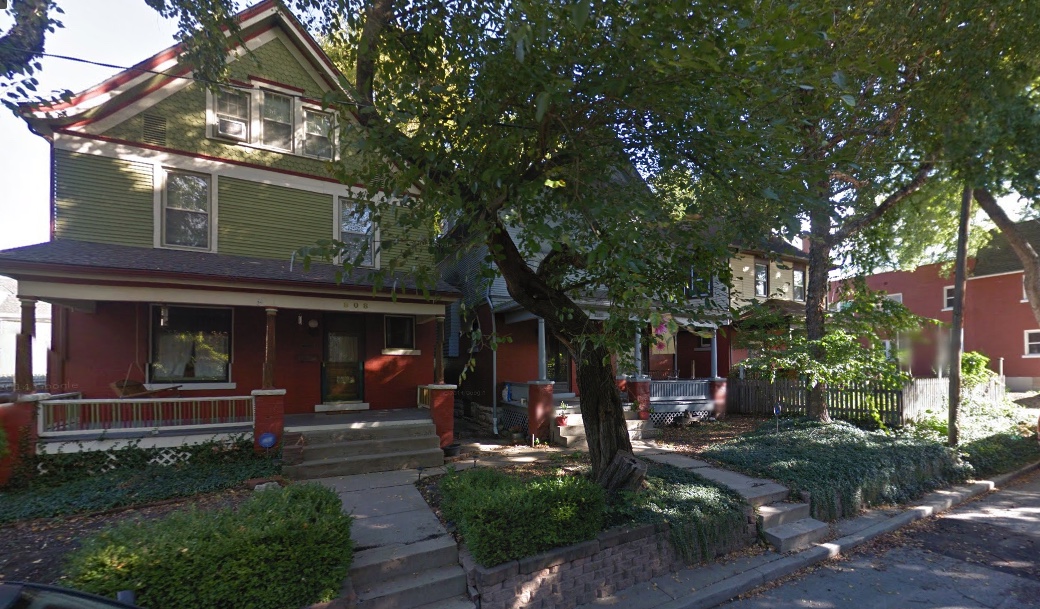
(This post was originally published on June 18, 2017)
Fewer than a dozen homes lined what was once known as Glen Airy Place in the North Hyde Park neighborhood, but the street still retains a tucked-away quality that sets it apart from other streets around it.
Reader Dale Ealey recently asked what history is known about this unique block.
The Kansas City Star noted the unusual secluded characteristics of the block in 1920, pointing out that Kansas City had a handful of such little roadways and streets. “Most of them are small courts, only a block in length, as a rule rather picturesque, and offering not unpleasant seclusion from the noise of more busy trafficways.”

A 1920 Kansas City Star article pointed out the unique characteristics of Gen Airy Place and a handful of other small, tucked-away streets.
Glen Airy Place stood between Charlotte and Campbell Streets between 31st Street and Linwood. Its name was changed to the more generic 31st Street Terrace in 1933, the year that Kansas City standardized street names.
As part of our Uncovering History Project, the Midtown KC Post is examining each block in Midtown. A set of 1940 tax assessment photos is available for many blocks.
Today the focus is on E. 31st Street Terrace between Charlotte and Campbell, a street formerly known as Glen Airy Place.


Home of the largest peaches
The homes on Glen Airy Place began going up in the early 1900s. According to the Hyde Park neighborhood web page, William E. Robbins built the 21/2 story shirtwaist in 1901. “Robbins lived just around the corner at 3111 Charlotte Street. The first residents were Mr. and Mrs. John T. Rosbrook; Mr. Rosbrook was vice-president of a company bearing his name. By 1908, this address had become the home of Frederic and Nellie Degitz. Fred held many jobs during his lifetime, including a conductor on the Main Street Railway and a post office clerk. Nellie was a dressmaker who worked from home. The Degitz family lived at this address for half a century—from 1908 until 1959. The house was subdivided into two apartments in the 1960s. “
The Cowherd Brothers, who erected many homes across Midtown, built the seven-room brick and frame home at 815 Glen Airy in 1904 and put it up for rent.
One of the better-know early residents of the street was Irish immigrant George C. Johnson, who lived at 812 Glen Airy. Well-known for his civic engagement, many were surprised when Johnson took advantage of a new immigration law in 1911 to actually become a citizen – something he had not been aware he needed to do.
“After living in America sixty-two years, in which time he voted many times, held public office and had been the principal of a city school, George C. Johnson of 812 Glen Airy Place was in the United States Circuit Court this morning as an applicant for naturalization,”
“One of the witnesses in court to testify to his good character was E.E. Aleshire, who once challenged Mr. Johnson’s very right as a voter and thereby apprised him of the fact that he was not a citizen of the United States.
“Under a new federal immigration law the applicant was made a legal voter this morning without the formality of taking out ‘first papers.’
“Mr. Johnson was brought to this country from Ireland by his mother in 1849, when he was 5 years old. By the time he had grown to manhood he had become so thoroughly Americanized that it never occurred to him that he lacked any of the rights and privileges of nativity. He took an active interest in politics, voted in all elections and became an educator. In 1880 he was a resident of Stanberry, Mo. where he held the position of principal of the first grade school in that place, and afterward held public office there. At Stanberry he made the acquaintance of E. E. Aleshire, who, after more than a quarter of a century of friendship, was called upon to challenge Mr. Johnson’s right to register as a legal voter in Kansas City.
“The new citizen now is a fruit dealer and well-to-do. He expressed himself this morning as proud and pleased that he was no longer an alien in a foreign land.” –The Kansas City Star, June 26, 1911.
On the south side of the street, the D.A. Rouner family lived at 805 Glen Airy for almost three decades. Mrs. Rouner was known for her record-setting large peaches. In 1911, she won a peach growing contest with her pair of Elbertas weighing twelve ounces each. She reminded people, however, that her peaches had been even larger the year before, when there was more rain.
Across the street at 814 Glen Airy, retired plasterer F.L. Wallace made news when he decided to end his own life in 1910 ”by taking four and one-half grains of morphine. “He left notes explaining that he had taken the drug because he was tired of life and its accompanying pain and requesting that no coroner’s inquest be held. Wallace had been ill fourteen years. He is survived by a widow and four children,” reported the Kansas City Star March 10, 1910.

Historic photos courtesy Kansas City Public Library/Missouri Valley Special Collections.
There used too be a quaint, charming sign at the west (Charlotte) end of the Glen Airy block–I fortunately was able to get a photo of it before the city removed it several years ago! Boo! A couple of years ago someone built a very rustic-looking wooden sign to replace the original sign. Yay! I have a photo of it, too.
It is an interesting block! No sidewalks, a narrow street, and tiny front yards bring the houses almost face-to-face.